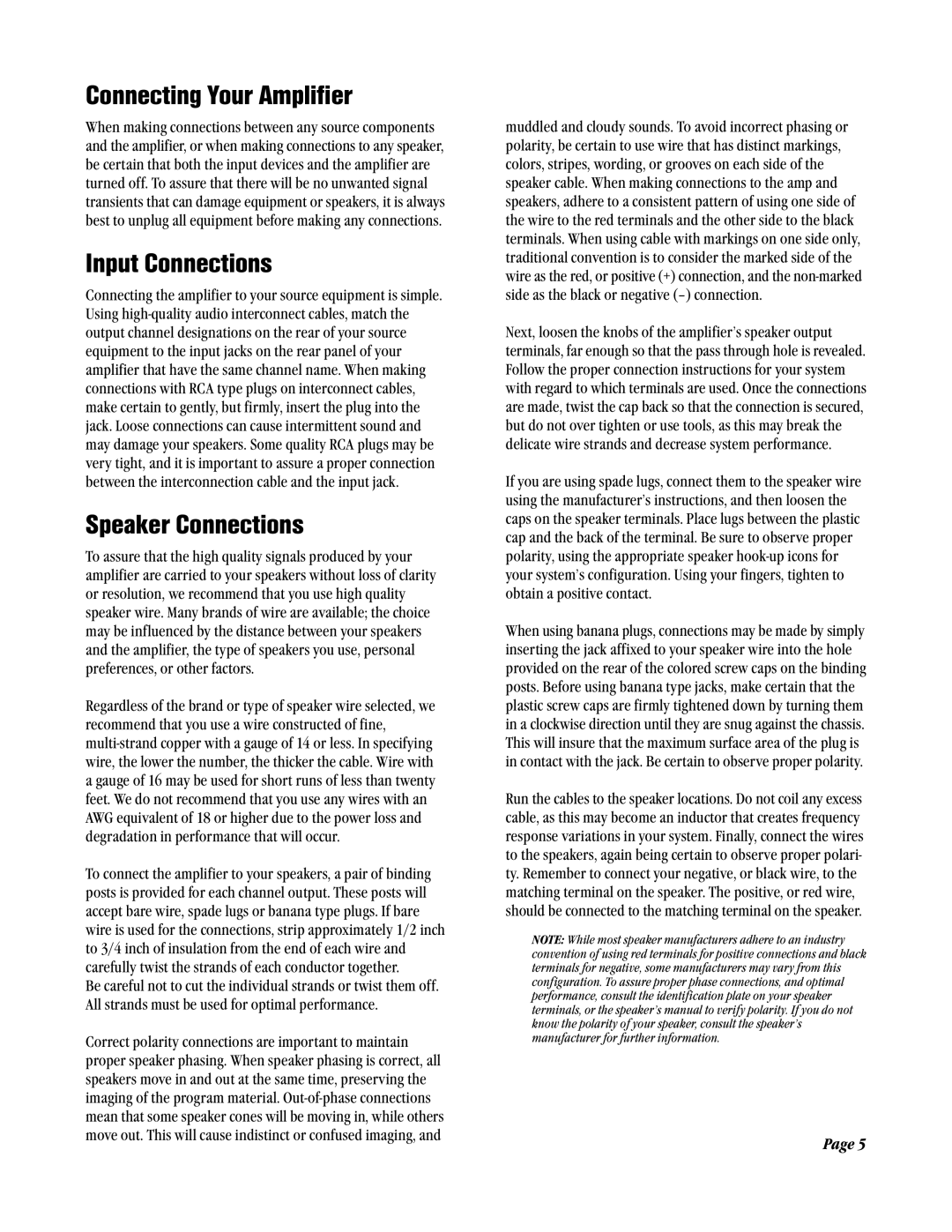Connecting Your Amplifier
When making connections between any source components and the amplifier, or when making connections to any speaker, be certain that both the input devices and the amplifier are turned off. To assure that there will be no unwanted signal transients that can damage equipment or speakers, it is always best to unplug all equipment before making any connections.
Input Connections
Connecting the amplifier to your source equipment is simple. Using high-quality audio interconnect cables, match the output channel designations on the rear of your source equipment to the input jacks on the rear panel of your amplifier that have the same channel name. When making connections with RCA type plugs on interconnect cables, make certain to gently, but firmly, insert the plug into the jack. Loose connections can cause intermittent sound and may damage your speakers. Some quality RCA plugs may be very tight, and it is important to assure a proper connection between the interconnection cable and the input jack.
Speaker Connections
To assure that the high quality signals produced by your amplifier are carried to your speakers without loss of clarity or resolution, we recommend that you use high quality speaker wire. Many brands of wire are available; the choice may be influenced by the distance between your speakers and the amplifier, the type of speakers you use, personal preferences, or other factors.
Regardless of the brand or type of speaker wire selected, we recommend that you use a wire constructed of fine, multi-strand copper with a gauge of 14 or less. In specifying wire, the lower the number, the thicker the cable. Wire with a gauge of 16 may be used for short runs of less than twenty feet. We do not recommend that you use any wires with an AWG equivalent of 18 or higher due to the power loss and degradation in performance that will occur.
To connect the amplifier to your speakers, a pair of binding posts is provided for each channel output. These posts will accept bare wire, spade lugs or banana type plugs. If bare wire is used for the connections, strip approximately 1/2 inch to 3/4 inch of insulation from the end of each wire and carefully twist the strands of each conductor together.
Be careful not to cut the individual strands or twist them off. All strands must be used for optimal performance.
Correct polarity connections are important to maintain proper speaker phasing. When speaker phasing is correct, all speakers move in and out at the same time, preserving the imaging of the program material. Out-of-phase connections mean that some speaker cones will be moving in, while others move out. This will cause indistinct or confused imaging, and
muddled and cloudy sounds. To avoid incorrect phasing or polarity, be certain to use wire that has distinct markings, colors, stripes, wording, or grooves on each side of the speaker cable. When making connections to the amp and speakers, adhere to a consistent pattern of using one side of the wire to the red terminals and the other side to the black terminals. When using cable with markings on one side only, traditional convention is to consider the marked side of the wire as the red, or positive (+) connection, and the non-marked side as the black or negative (–) connection.
Next, loosen the knobs of the amplifier’s speaker output terminals, far enough so that the pass through hole is revealed. Follow the proper connection instructions for your system with regard to which terminals are used. Once the connections are made, twist the cap back so that the connection is secured, but do not over tighten or use tools, as this may break the delicate wire strands and decrease system performance.
If you are using spade lugs, connect them to the speaker wire using the manufacturer’s instructions, and then loosen the caps on the speaker terminals. Place lugs between the plastic cap and the back of the terminal. Be sure to observe proper polarity, using the appropriate speaker hook-up icons for your system’s configuration. Using your fingers, tighten to obtain a positive contact.
When using banana plugs, connections may be made by simply inserting the jack affixed to your speaker wire into the hole provided on the rear of the colored screw caps on the binding posts. Before using banana type jacks, make certain that the plastic screw caps are firmly tightened down by turning them in a clockwise direction until they are snug against the chassis. This will insure that the maximum surface area of the plug is in contact with the jack. Be certain to observe proper polarity.
Run the cables to the speaker locations. Do not coil any excess cable, as this may become an inductor that creates frequency response variations in your system. Finally, connect the wires to the speakers, again being certain to observe proper polari- ty. Remember to connect your negative, or black wire, to the matching terminal on the speaker. The positive, or red wire, should be connected to the matching terminal on the speaker.
NOTE: While most speaker manufacturers adhere to an industry convention of using red terminals for positive connections and black terminals for negative, some manufacturers may vary from this configuration. To assure proper phase connections, and optimal performance, consult the identification plate on your speaker terminals, or the speaker’s manual to verify polarity. If you do not know the polarity of your speaker, consult the speaker’s manufacturer for further information.
Page 5
